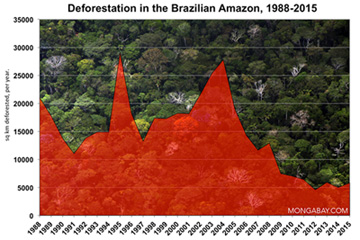Brazil splits environmental agency to fast-track development projects
Brazil splits environmental agency to fast-track development projects
Rhett A. Butler, mongabay.com
April 25, 2007
Brazil will divide its environmental protection agency IBAMA into two separate entities reports Reuters. The move is expected to speed development projects in the Amazon rainforest.
“Ibama will take care exclusively of supervision, licensing and authorization relating to the environment,” Environment Minister Marina da Silva said at a news conference, according to Reuters.
The announcement came just days after President Luiz Inacio Lula da Silva complained about delays in the construction of two large hydropower dams in the Amazon due to environmental impact studies.
Lula da Silva hopes the separation will fast-track infrastructure projects in sensitive areas, a development that worries environmental groups.
“Conservationists seeking to protect the endangered Amazon, the world’s largest rain forest, say they fear the government will try to ram through its development plans,” reports Reuters.
Conservation will now be handled by a new agency called the Institute of Biodiversity.

DEFORESTATION IN BRAZIL: 60-70 percent of deforestation in the Amazon results from cattle ranches while the rest mostly results from small-scale subsistence agriculture. Logging results in forest degradation but rarely direct deforestation. However, studies have showed a close correlation between logging and future clearing for settlement and farming. Graphic by R. Butler. |
Since 2002 the Brazilian government has moved to reign in forest clearing by setting aside more than 100 million hectares of the Amazon basin from development and cracking down on illegal activities. These efforts, combined with lower commodity prices may be paying off: forest loss for the 2005-2006 year was down more than 40 percent from the prior year. The 2005-2006 figure — 13,100 square kilometers (5,057 square miles) — is the lowest since 1991 when 11,130 square kilometers (4,258 square miles) of forest were lost.
The Amazon is Earth’s biggest rainforest, but since the early 1970s about 650,00 square kilometers (250,000 square miles), or 18 percent of the forest area — have been destroyed. In recent years road construction, clearing for agriculture and cattle pasture, and logging have been responsible for most forest loss. Scientists say that continued forest loss could turn much of the Amazon rainforest into savanna, putting the region’s biodiversity at risk — the Amazon may be home to as much as one-third of the planet’s terrestrial species.
This report used quotes and information from “Brazil to Split Up its Environmental Agency” (Reuters) and previous mongabay.com articles.